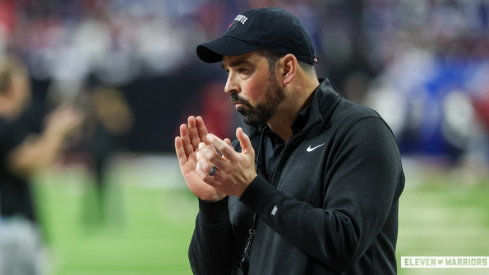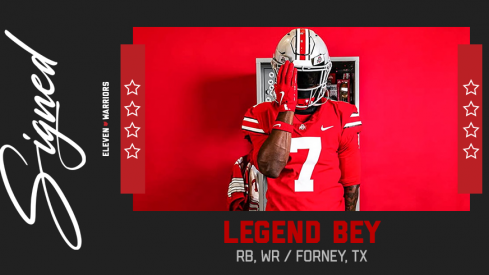
The Ohio State defense gave up over 500 yards and 28 points in flirting with disaster against Cal. Yet a whopping forty percent of those yards were on six plays. Granted, the Buckeye defense was at times left in a precarious position by offensive three and outs and poor punting, but that cannot adequately explain the big play problem. The Ohio State defense has now given up 13 plays of 20+ yards. So these big plays cannot be explained away as skewing stats. They instead are the problem. So, as with last week, we ask whether the defense has a schematic problem, a personnel problem, or an execution problem. And, as with last week, the answer is all of the above.
A Schematic Breakdown
Last week, I referenced that UCF took advantage of the fact that Ohio State was putting their front strength to the field by putting their formation strength into the boundary to gain a numbers' advantage. Cal saw this on film and put it on steroids. As background, the reason that a defense plays an over or under shaded front is to maintain an arithmetic advantage to the tight end side. The defense can have four defenders to the strength versus three for the offense, and three to two to the weak side. This also then provides a defender for every gap.

The shade also allows the over or under front to put the seven technique (above the Sam linebacker) in an outside leverage so that he can act as a 'force' player. Nearly every defense ever created has an individual responsible for force, aka contain. Their responsibility is to maintain outside leverage and play inside-out against a player running a sweep to force them back inside into the defensive pursuit. A defense then has their linebacker that is filling maintain outside leverage and further 'spill' the ball carrier inside. The reason is simple—big plays come from when an offensive player gets the corner. So ideally it works thusly:

The force player can also be a corner away from twins or a cover 3 strong safety (as OSU is demonstrating to the field side above). But the point remains that all defenses need such a player. The problem for Ohio State was that by continually putting its formation to the field, it lost both its numeric advantage and force contain against a Cal offense that puts its tight end to the boundary. So OSU was left with this disadvantage pre-snap.

From there, Cal attacked the edge by running stretch into the boundary and Ohio State simply had no method to prevent the tailback from getting the corner. It became an easy hook block by the tight end.
It is overly simplistic to say that a defense should always fit their front to the formation or that there is never a reason to play to the field. But like anything else, if you are predictable in your tendencies the opposition can respond and Cal gained multiple big plays in response, as Urban Meyer recognized. Shoring up this issue alone should reduce the possibility for big plays.
On Tackling and Pursuit
But not all of the Buckeye defensive problems can be explained away to this issue. Instead, even when Ohio State had the proper formation, Buckeye players failed to execute the two fundamentals of defensive football, that being proper a) tackling and b) pursuit angles. OSU's tackling problems come in two contradictory patterns. One is what I would call 'belly bumping.' Whether because they are overly concerned about holding up a ball carrier to cause a fumble or simply not playing with the requisite physicality, OSU is not getting running backs down immediately.
On the opposite side, too many Buckeyes are throwing a shoulder into a ball carrier without wrapping up, allowing offenders to bounce off tackles.
Poor pursuit angles may be a more insidious issue. Missed tackles are exacerbated by backside defenders failing to flow to the football as diagrammed above. Again I see two overlapping issues. One is players taking angles that vastly overestimate their speed relative to the ball carrier.
The second is slow recognition, which is causing defenders to be out of position. All the above issues were present on Bigelow's 80+ touchdown run.
Nathan Williams does not widen with the running back and cannot make the tackle. Etienne Sabino is slow in recognition and then takes a poor angle, taking himself out of the play. Ohrian Johnson tries to catch the running back high, missing a tackle. Ryan Shazier throws his shoulder at the running back, leading to another missed tackle. Finally, safeties CJ Barnett and Christian Bryant take poor angles, quit on the play, and then get caught in the wash. While you have to give credit for a great run, it was permitted by a team lapse in fundamentals.
Be Careful what you wish for: Man Coverage Edition
The other primary cause of explosive plays was Ohio State getting beat in man coverage. OSU played more first-half man coverage in an attempt to increase pressure. The problem for OSU in doing so is not their cornerbacks, who are a strength of this team. But Ohio State still has to account for three other receiving threats and does not have linebackers and safeties whose strength is man coverage. For instance, here is the jailbreak screen that Cal had so much success with. OSU blitzes and plays man coverage behind it. Sometimes you have to tip your cap to the opposing team for having a screen call when the defense blitzes, but the man coverage defenders are slow to react and get blocked.
Here are two more classic examples. In the first, Sabino is responsible for the tailback. He slips trying to adjust in coverage, and the result is a touchdown (called back by holding) because the defensive backfield's backs are turned in coverage. This will never be a fortuitous matchup for OSU.
In the second, Barnett swivels the wrong way, allowing himself to get beat down the seam.
The Buckeyes largely moved away from man coverage in the second half and were able to cut down upon big plays in the passing game.
Personal Personnel
The above segment raises the question whether the Buckeye defense has the personnel to succeed. Ohio State is very strong up front and at corner but has often received subpar play from its linebackers and safeties. This has led to the big play breakdowns once opponents break the initial wave. As usual, I think we need to parse the issue farther. Ryan Shazier and the safeties have talent but are (relatively) inexperienced and thus make mistakes. They will fly to the football and make plays but also have occasional lapses in pursuit and tackling. This would be manageable if they were being covered by experienced players but they are not. Yet improvement is evident. For example, Bryant began playing very well after the Bigelow run, emphasizing wrapping up.
Ohio State's primary personnel weakness is they simply do not have anyone available to play Mike linebacker in either base or nickel. Sabino is far more suited to Sam and does not have the instincts or quickness to play the middle. Curtis Grant is not ready, particularly in the pass game. Storm Klein added a slight upgrade and it will be interesting to see if he can take over the position. But Ohio State's defense is largely missing someone for this position. It is unfortunate, because it limits them in using Shazier as a rusher, who showed how explosive he can be off the edge, because they simply do not have other linebackers.
So is it fixable?
Credit should be given to Cal. Jeff Tedford is an offensive mind, and Cal had a excellent "underdog" game plan heavy on misdirection with a diet of bootlegs and screens in addition to the exploitation of OSU's schematic issues. Yet OSU's wounds were also self-inflicted. The Buckeyes fixing the boundary issue as Meyer described would go a long way to preventing the systemic surrendering of big plays. OSU can also do so by not being so quick to go to its odd nickel front. Again, it blurs gap responsibilities and should be saved for must-pass downs. Ohio State was more successful in the fourth quarter operating from its 4-2-5 over nickel.
OSU also needs to protect its linebackers and safeties in coverage. This will require OSU's front four to continue to produce pressure on its own. Lost in the big plays was that Ohio State's defensive line played its best game. Johnathan Hankins was virtually unblockable in the middle, and Nate Williams' return provides added versatility. The defensive coaching staff also needs to cut down on the linebackers jumping around pre-snap, which are taking them out of position (as shown in the clips above). The theory is that it prevents the offense from knowing their intentions, but OSU needs to focus on the fundamentals such as gap responsibilities first.
The defense needs to take a page from the offensive staff and let an inexperienced back seven run before it walks. These are fixable issues and the coaching staff should take a building block approach to correct them.


